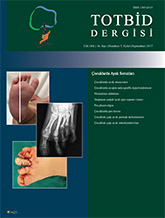
Congenital clubfoot is probably the most common (1–2 in 1000 live births) orthopaedic anomaly requiring intensive treatment. It represents dysplasia of all musculoskeletal and neurovascular structures distal to the knee. It may be positional because of intrauterine position of the feet during pregnancy or it may be associated with conditions such as arthrogriposis, myelodysplasia, Streeter`s dysplasia, Freeman Sheldon syndrome, Möbius syndrome and Down syndrome. However, most common presentation is idiopathic clubfoot in an otherwise normal infant. It can as well as be diagnosed with maternal ultrasound starting from 12. week of the pregnancy or with physical examination after birth. Treatment of the newborn should be started as early as possible. Parental education about the disease and course of the treatment improves compliance and prevents possible recurrences. At present, excellent results can be achieved with conservative methods, thus surgical treatment should be reserved for residual or recurrent deformities. In conservative treatment, respectively, Ponseti method and French functional method are used most commonly. Surgically, various soft tissue releases and bony procedures may be performed. Main goal in the treatment is to obtain plantigrade, functional and pain-free feet.